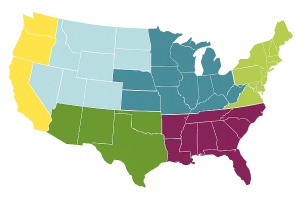Wyoming Native Plants, State Flower & State Bird
Posted By American Meadows Content Team on Sep 27, 2012 · Revised on Sep 23, 2025

Knowing your location helps us recommend plants that will thrive in your climate, based on your Growing Zone.
Posted By American Meadows Content Team on Sep 27, 2012 · Revised on Sep 23, 2025
Native plants are adaptable, low-maintenance, and beautiful. They are the best choice for habitat-friendly gardens and thriving ecosystems. Find top picks for native plants in your state - and learn about your state bird and state flowers!
Follow Along With More Of Our Guides
Hello native plant enthusiasts! In the list below, you will find popular native plants and wildflower seeds, available from American Meadows, that have a native distribution in your state. You’ll also find information about your state bird, state flower, and state wildflower!
Grow our Native West Wildflower Seed Mix
Showy Goldenrod (Solidago speciosa)
Black Eyed Susan or Gloriosa Daisy (Rudbeckia hirta)
Yellow Prairie Coneflower (Ratibida columnifera)
Swamp Milkweed (Asclepias incarnata)
Long Beaked Sedge (Carex sprengelii)
Firewheel (Gaillardia pulchella)
Blanket Flower (Gaillardia aristata)
Wild Strawberry (Fragaria virginiana)
Plains Coreopsis (Coreopsis tinctoria)
Lanceleaf Coreopsis (Coreopsis lanceolata)
Wild Bergamot (Monarda fistulosa)
Elderberry (Sambucus canadensis)
Meadow Anemone (Anemone canadensis)
Anise Hyssop (Agastache foeniculum)
Big Bluestem (Andropogon gerardii)
Little Bluestem (Schizachyrium scoparium)
Tufted Hair Grass (Deschampsia cespitosa)
Yellow Prairie Grass (Sorghastrum nutans)
Aromatic Aster (Symphyotrichum oblongifolium)
New England Aster (Symphyotrichum novae-angliae)

Western Meadowlark ~ Sturnella neglecta
In plumage there is little to distinguish the Western Meadowlark from his eastern counterpart. Both have streaked upper parts, a yellow breast with a black V, and white outer tail feathers. The Westerner, however, is somewhat paler. In the realm of song, all resemblance ceases. Unlike the Easterner’s plaintive, whistled song; the Western Meadowlark’s phrases contain hints of the wood thrush, the Baltimore oriole, and the bobolink.
Indian Paintbrush ~ Castilleja linariaefolia
The Indian paintbrush is one of a group of plants that seem, at first glance, to bear bright flowers, but a closer look shows that appearances are sometimes deceiving. Actually, the tubular creamy flowers, about one inch in length, are almost hidden="hidden" by the sepals, which are tipped with orange-red, and the light-red bracts, which are one-to-two inches long. The real leaves are green. They, and the rest of the plant, are covered with short fine hairs. This member of the figwort family grows to about two feet in height, and near the ground, it divides into several stalks which in turn have little branches. The plant resembles a paintbrush.
From The Wildflowers of the 50 States U.S. stamps issued July 24, 1992:

